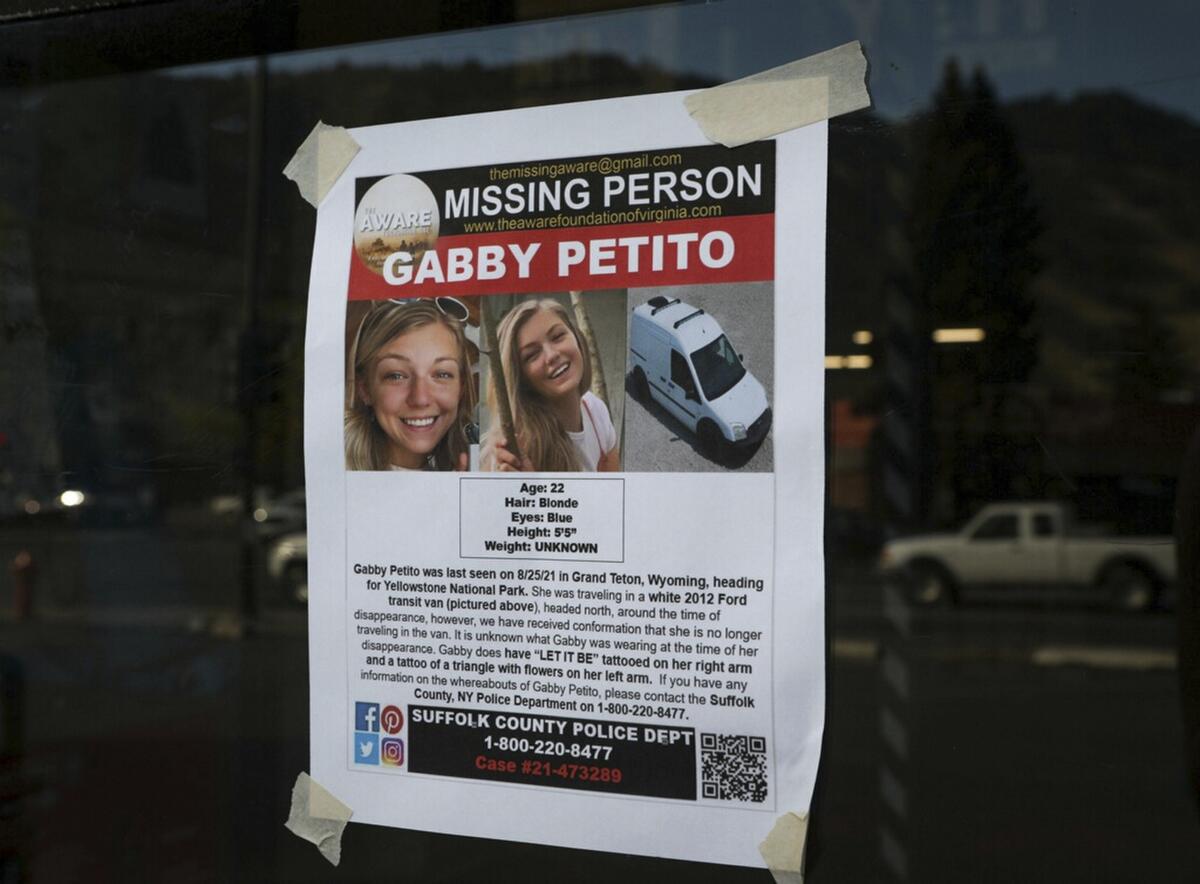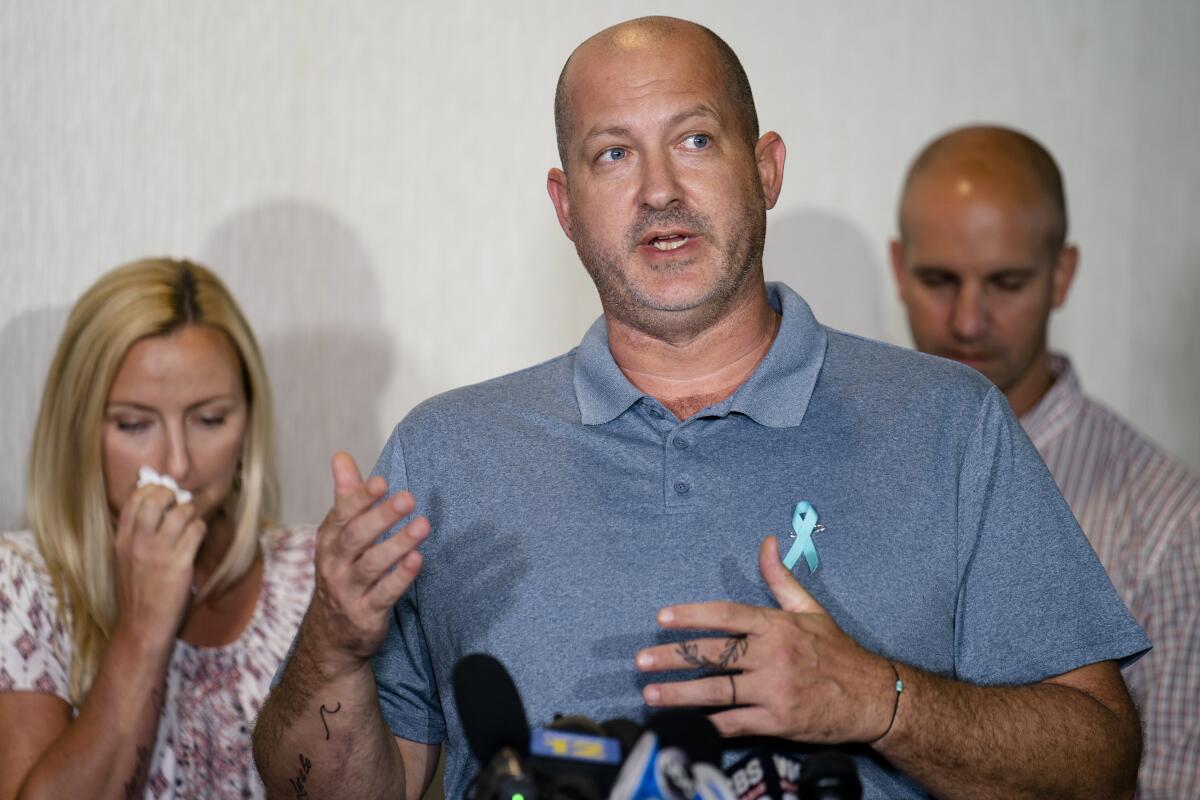Gabby Petito and one way to break media’s ‘missing white woman syndrome’

- Share via
Many journalists are burdened with an awareness of their industry’s overindulgences to the point of loathing. It was 2004 when the TV news journalist Gwen Ifill popularized a now-famous term, almost offhandedly, during a conference panel where journalists bemoaned new media’s mania for selectively covering sensational individual criminal cases instead of meatier international humanitarian crises. “I call it the ‘missing white woman syndrome,’” said Ifill, who broke several barriers as a Black and female journalist. “If there’s a missing white woman, you’re going to cover that, every day.” The audience started applauding Ifill’s quip, because anybody smart enough to turn on a TV could see it was true.
In a book published the same year, satirical newsman Jon Stewart restated the problem algebraically, estimating that the minutes of TV news coverage would equal Family Income x (Abductee Cuteness ÷ Skin Color)2 + Length of Abduction x Media Savvy of Grieving Parents3.
Washington Post columnist Eugene Robinson, the next year, observed: “The specifics of the story line vary from damsel to damsel. In some cases, the saga begins with the discovery of a corpse. In other cases, the damsel simply vanishes into thin air. Often, there is a suspect from the beginning — an intruder, a husband, a father, a congressman, a stranger glimpsed lurking nearby.” But the media’s missing woman is always white, said Robinson, whose column set off a wave of renewed commentary and reflective news coverage.
Some news outlets responded self-consciously by deliberately featuring the cases of missing women of color who had otherwise escaped saturation coverage that missing white women had received, as if to balance accounts. This particular cycle of missing-white-woman story, self awareness and mild corrective effort was happening 15 years ago. It’s happening now, a tidal loop that won’t break unless journalists try something new.
Each year, there is an unimaginable sum of suffering, fear and uncertainty experienced by hundreds of thousands of Americans with a loved one gone missing. People disappear to escape families, to escape abusers, to escape debtors, to start over. Some struggle with substance abuse or mental health problems that have frayed bonds with home. Others have been taken against their will. Some disappeared because they were killed, like Gabby Petito, 22, who disappeared while on a road trip with her boyfriend, Brian Laundrie, who is being sought by authorities.
Her story is likely to receive far more media coverage than any other missing-persons case this year, raising the same old skepticism of the implicit racism and classism driving traditional newsrooms’ determination of whose suffering is news and whose suffering isn’t interesting. Petito’s family, while welcoming the amount of attention her story has gotten after her remains were found in Bridger-Teton National Forest in Wyoming, has been moved amid its grief to mark the inequality and ask for change.
“I want to ask everyone to help all the people that are missing and need help,” her father, Joseph Petito, said at a Tuesday news conference in Bohemia, N.Y. “It’s on all of you, everyone that’s in this room, to do that, and if you don’t do that for other people that are missing, that’s a shame. It’s not just Gabby that deserves that. So look to yourselves for why that’s not being done.”

On one level, the cause of the imbalance seems simple. “The same reason why media coverage is different for white women than for women of color is the same reason this is getting so much attention,” said Gina Masullo, associate professor of journalism and media at the University of Texas at Austin. “We live in a system that puts white women at a higher value.”
The way this systemic bias gets expressed through missing-persons coverage, however, is a little more convoluted, according to a 2020 study in the academic journal Journalism Practice, which interviewed editors, publishers, news directors, reporters and law enforcement officers in California and New York about how missing-persons cases are handled in the press. The article concluded that police, not media, were often the real driving force determining which cases got media attention and which didn’t.
“If we get the information from the police, then we put it up immediately,” one California journalist told the researchers, who anonymized their interviewees. “If we just hear about it from a family, we will call the police and see whether there’s been a report filed.” A New York journalist was blunter: “Our policy is, if it doesn’t come from the police, we’re not gonna put it on.”
Law enforcement understands its role in this media ecosystem well. “They’ve never turned us down; they’ve never not put a kid on the news when we’ve asked them to,” one New York law enforcement official told the researchers. A New York detective added: “I don’t want to put so many kids on the news that the public will be like, ‘Oh, it’s just another runaway.’ So I decide who to put on the news and not to put on the news.”
In an email to The Times, one of the study’s authors, Carol Liebler, a communications professor at Syracuse University, summed up her own conclusion: “Police have way too much influence in determining which missing people the news media cover. They are real gatekeepers in that regard.”
Petito’s family went public on Sept. 11 after going to police, giving some details in their Facebook page’s initial post but adding that they “cannot give any other information as it is under investigation.” By the next day, Petito’s disappearance was already national news, with police giving some details to outlets like Fox News.
Social media users quickly became participants in the same downstream media ecosystem as traditional newsrooms, scouring and publicizing Petito’s own social media presence, which included a YouTube channel and an Instagram account where she was documenting her cross-country “van life” trip.
Police have continued releasing details driving attention to the case, including body camera footage of a Utah officer interviewing Petito after the couple had a fight in which Petito said the pair hit each other. Mainstream media have once again done their part sticking with the story, leading some commentators to ask for other ways of more equitably covering similar tragedies.
Annette Lawless, a news anchor and investigative reporter found herself pondering that same question several years ago. While working as a television journalist in Cleveland in 2013, news broke that police had rescued three missing women — Amanda Berry, Gina DeJesus and Michelle Knight — whom a man had kidnapped and held hostage in his home for years.
Lawless had known about Berry’s case. “Her family had been really persistent through the years, sharing her story, holding vigils, constantly contacting us,” Lawless said. “The other girls we weren’t really familiar with.” The inequity didn’t sit right with her.
Three years ago, after taking a job at ABC affiliate KAKE-TV in Wichita, Kan., Lawless started a project to cover as many missing-persons cases as possible, called Missing in Kansas. Rather than picking and choosing which cases are most sensational, Lawless’ project is less subjective and more democratic: In segments that air every weekday in the morning and evening, she covers all sorts of missing-persons cases, whether they’re young, old, white, Black, Latino, male, female, whether they were abducted, whether they’re runaways, whether they’re rich, whether they’re poor.
“People of all backgrounds,” Lawless said. “We cover so much that I feel like we cover everybody.”

Lawless keeps a spreadsheet of the stories the station has taken, and it’s approaching the 1,000-person mark. “I track all the cases, the success rate,” Lawless said. “We’re close to 90% with a closure rate.” (Nationally, most missing people are eventually found.)
“Annette Lawless is doing really important work, and kudos to her news director for supporting it,” said Liebler, the scholar who studied police’s influence on missing-persons coverage, who has also studied the “missing white woman syndrome.” “I feel Missing in Kansas is definitely a model for other news organizations.”
The station invites viewers to contact Lawless about cases they think it should cover. While Lawless prefers to check with a state police database to see whether a missing-persons report has been filed, she doesn’t wait for police to tell her who to cover.
“When I started this, I had cold-called all the major metro police departments and every sheriff’s office in the state to ask if you have missing people,” Lawless said. “It was a little frustrating when they told me, ‘No, we don’t.’”
She knew it wasn’t true. People go missing all the time. It’s just that not everybody has been looking for them. But she would.
More to Read
The biggest entertainment stories
Get our big stories about Hollywood, film, television, music, arts, culture and more right in your inbox as soon as they publish.
You may occasionally receive promotional content from the Los Angeles Times.











